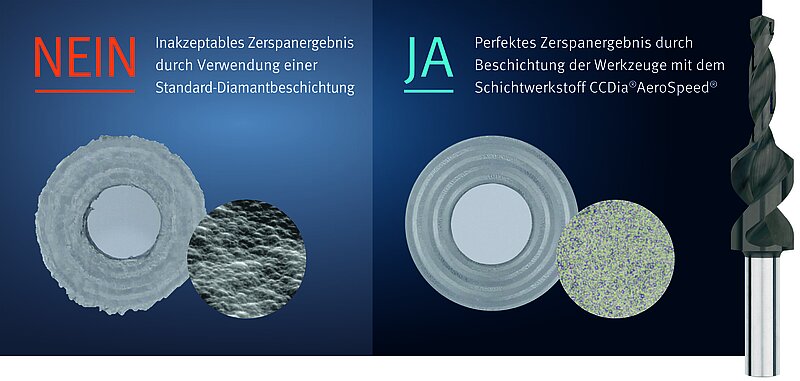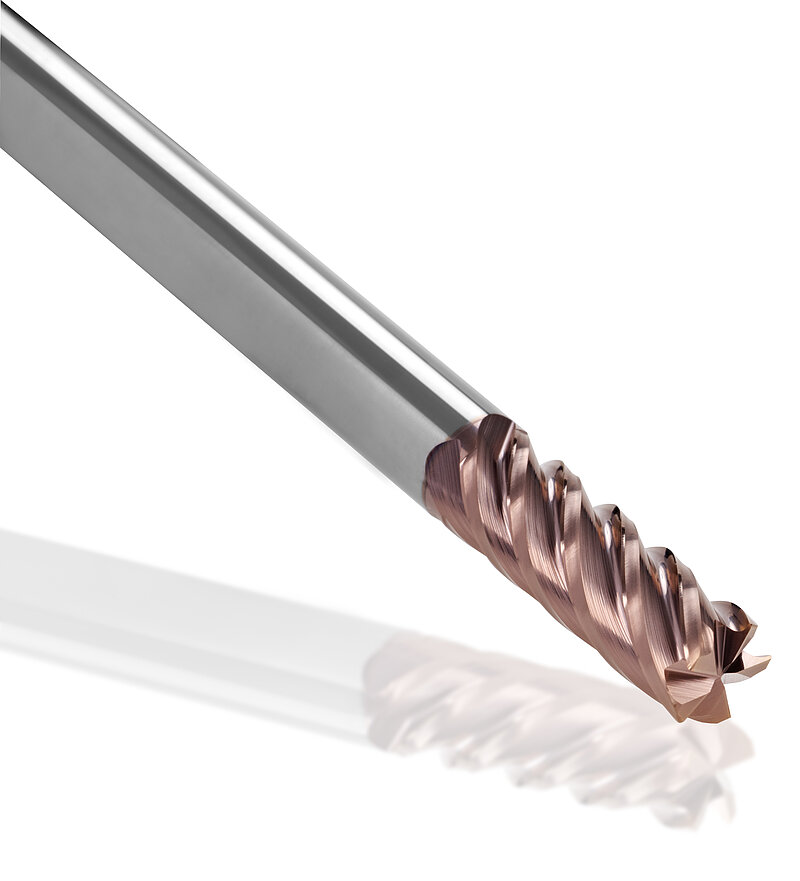Machining difficult-to-machine materials: Easier lift-off with diamond and HiPIMS coatings
Lightweight materials combine low weight with high strength and stability. In machining, however, they are real heavyweights. When drilling and milling hard and at the same time tough special alloys or composite materials for aircraft construction, Cemecon premium coatings ensure high process reliability, enable very good production quality and at the same time ensure long-term economic efficiency.
When touching down on the runway, a gentle jolt goes through the fuselage of the aircraft. And there is also quite a bit of movement in the aircraft during flight; everyone can observe this - depending on where they sit - at the wingtips. It's good to know that airplanes are by no means as rigid as they appear at first glance. In fact, they are trimmed for elasticity through and through. The titanium alloys used in aviation are perfectly designed for this. They are very tough and therefore particularly resistant to the constant dynamic stress caused by vibrations and oscillations in flight operations. As a result, aircraft remain safe throughout their entire service life - common models are designed for 25 years, 60,000 flight hours and 48,000 landings, and generally last much longer.
Maximum service life thanks to SteelCon's high silicon content
In addition, with a relatively low density of 4.5g/cm3, titanium has high strength combined with very low weight. Components made of titanium are highly resistant to corrosion and are electrochemically compatible with CFRP. "However, the high hardness and toughness of titanium combined with its very poor thermal conductivity and strong tendency to adhesion make machining enormously difficult. That's why cutting tools have to be particularly wear- and temperature-resistant in order to master the process economically," says Manfred Weigand, Product Manager Round Tools at Cemecon. "Our new HiPIMS coating material SteelCon is made for this. SteelCon provides the hard shell that optimally protects the tool when machining titanium."
Due to its composition, the HiPIMS coating material has enormous thermal stability. Furthermore, SteelCon provides excellent thermal insulation and hardly lets any heat into the tool, but dissipates it via the chip - perfect for machining titanium. Without SteelCon, the high temperatures that inevitably arise when machining the hard material would damage the tool and embrittle the carbide. In addition, SteelCon is highly wear-resistant, partly due to its high hardness and toughness, and partly thanks to its excellent adhesion. This combination of properties results in significantly longer tool life and excellent machining results. With HiPIMS, coatings become very dense with extremely good adhesion. This makes SteelCon the ideal base for coating titanium machining tools.
Titanium, like aluminum, is increasingly being used in modern aircraft in combination with composite materials - sandwiched with carbon fiber-reinforced plastics. "Drilling a hole in a component that is first porous and highly abrasive and then soft and tough in proportion? That places special demands on the substrate, cutting geometry and coating," Manfred Weigand describes the experience. "CCDiaAeroSpeed - originally designed for CFRP machining - also offers a balanced solution for the CFRP and aluminum duo." The nanocrystalline diamond surface is extremely smooth and chemically inert - which is why it also ensures effective chip removal. CCDiaAeroSpeed-coated tools are also particularly sharp, as the edge rounding of the cutting edge is many times less than with conventional diamond coatings of the same thickness. With CCDiaAeroSpeed, burrs of less than 0.1mm can be achieved when the drill emerges from the aluminum composite layer - thus meeting a widespread standard in aircraft construction.
Multilayer diamond coatings from Cemecon are also emerging as the right way forward for the current topic of CFRP titanium machining. "Current trials show that we will soon be the first to achieve much more economical machining of this composite material," Manfred Weigand casts a glance into the future.
![[Translate to English:] InDiamond.world](/fileadmin/_processed_/a/1/csm_InDiamond_Logo_2021_1fb017de30.png)

